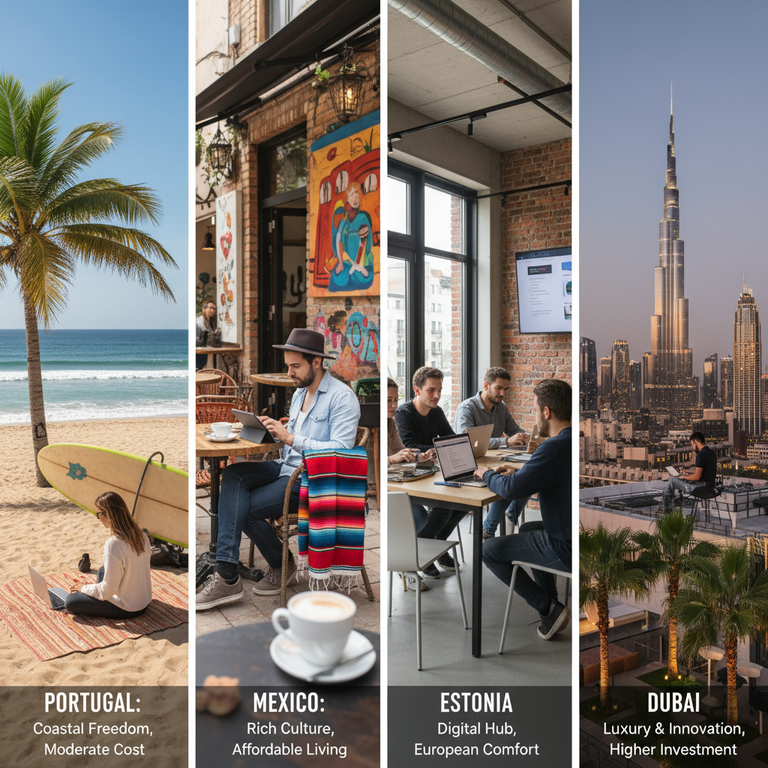Digital Nomadism: The 10 Best Countries with Specific Visas (and the Real Cost of Living)
The dream of **Digital Nomadism** is no longer a niche fantasy. What was once reserved for a handful of backpackers with laptops has exploded into a mainstream global movement. The “Great Remote Work Experiment” proved to millions that high-value professional work can be done from anywhere—so why not do it from a beach in Portugal, a café in Mexico City, or a co-working space in Estonia?
However, this dream often collides with a harsh reality: bureaucracy. For years, “digital nomads” existed in a legal grey area, hopping between countries on 90-day tourist visas, a practice that is both stressful and legally precarious. Governments have finally caught on. To attract this new class of high-earning, low-impact residents, dozens of countries have launched **specific visas for digital nomads**.
This guide is not a travel blog. It’s a strategic analysis for professionals. We’ll cut through the “Instagram” hype and focus on the two factors that *actually* matter: the availability of a legal visa and the **real cost of living** (not the tourist price). Here are 10 of the best countries that have rolled out the red carpet, not just the welcome mat.
What Is a ‘Digital Nomad Visa’ and Why Do You Need One?
A “Digital Nomad Visa” (or a similar “remote work” permit) is a long-term residency permit. It is *not* a tourist visa, and it is *not* a work visa (which would require you to be employed by a local company).
It allows you to live in a country for an extended period (usually 1-2 years, often renewable) while you work remotely for employers or clients *outside* of that country. It grants you legal status, allows you to rent an apartment long-term, and, in some cases, provides a pathway to tax residency. To qualify, you almost always need to prove three things:
- Proof of Remote Work: A remote employment contract or proof of a freelance business.
- Proof of Income: A minimum monthly income threshold (this is the key qualifier).
- Health Insurance: Comprehensive coverage for your entire stay.
The 10 Best Countries for Digital Nomads (Visa & Cost Analysis)
Here is a breakdown of top-tier destinations that combine strong legal frameworks with a high quality of life. (Note: Income thresholds and costs are estimates as of 2024/2025 and fluctuate. Always check official government sources before applying.)
1. Portugal (D8 ‘Digital Nomad’ Visa)
Why it wins: Portugal remains the “gold standard” for many. It offers an incredible quality of life, safety, beautiful landscapes, and a clear, attractive visa path within the EU Schengen Area.
The Visa: The D8 Visa (or the “short-term” remote work visa). It requires a minimum income of approx. €3,040/month (four times the Portuguese minimum wage).
The Real Cost of Living: While no longer “cheap,” it’s still affordable by Western European standards. Expect to spend $1,800 – $2,500/month in Lisbon or Porto. Secondary cities like Braga or Coimbra are significantly cheaper.
2. Mexico (Temporary Resident Visa)
Why it wins: Mexico doesn’t have a “digital nomad” visa per se, but its “Temporary Resident Visa” is perfect for it. It offers incredible food, diverse geography, and a vibrant culture, all on a North American time zone.
The Visa: You must apply from a Mexican consulate *outside* of Mexico. Requires proof of a monthly income of approx. $3,200 USD (or a bank balance of approx. $54,000) for the past 12 months. The visa is granted for one year and is renewable for up to four.
The Real Cost of Living: Varies wildly. Mexico City (in trendy areas like Condesa) can cost $2,000 – $2,800/month. Smaller hubs like Oaxaca or Merida can be comfortably lived on for $1,200 – $1,800/month.
3. Estonia (Digital Nomad Visa)
Why it wins: Estonia is a futuristic “digital-first” nation. It was one of the *first* countries to launch a **specific visa for digital nomads**. It’s modern, English is widely spoken, and it offers a gateway to Eastern Europe.
The Visa: A dedicated D-Visa for digital nomads. Requires a gross monthly income of €4,500. It can be granted for up to one year.
The Real Cost of Living: Higher than Portugal, lower than Scandinavia. A solo nomad can live very well in the beautiful capital of Tallinn for $1,600 – $2,200/month.
4. Spain (Digital Nomad Visa)
Why it wins: Spain’s long-awaited visa combines world-class lifestyle, amazing cities, and a fantastic climate. It also offers a significant tax break for the first few years under a special “Beckham Law” variation.
The Visa: Requires a minimum income of 200% of the Spanish minimum wage (approx. €2,600/month). You must prove a university degree or 3+ years of professional experience.
The Real Cost of Living: Varies by city. Barcelona and Madrid are more expensive ($2,200 – $3,000/month). Valencia or Seville offer an incredible lifestyle for $1,700 – $2,400/month.
5. Colombia (Digital Nomad Visa ‘V’)
Why it wins: Colombia has shed its past and is now a top destination, offering a “perfect” climate in cities like Medellin, low costs, and a friendly culture.
The Visa: A straightforward “V” visa for remote workers. Requires a minimum monthly income of just 3x the Colombian minimum wage (approx. $900 USD). It’s one of the most accessible **specific visas**. Valid for up to two years.
The Real Cost of Living: Excellent value. A comfortable, modern life in Medellin or Bogota can be had for $1,100 – $1,700/month.
6. Croatia (Digital Nomad Permit)
Why it wins: For those who dream of the Mediterranean, Croatia offers stunning coastlines, ancient history, and a safe, modern environment.
The Visa: A “temporary stay” permit for digital nomads. Requires a monthly income of approx. €2,540 (or a lump sum of €30,480). A key benefit: nomads on this permit are *not* subject to Croatian income tax.
The Real Cost of Living: Highly seasonal. Living in coastal cities like Split or Dubrovnik is expensive in the summer ($2,000 – $2,800/month) but cheaper in the off-season. The capital, Zagreb, is more stable at $1,500 – $2,100/month.
7. Greece (Digital Nomad Visa)
Why it wins: Another Mediterranean paradise. Greece offers an amazing lifestyle, and its visa is fast, efficient, and offers a 50% income tax reduction for the first seven years.
The Visa: Requires a monthly income of €3,500. You can also bring your family (income requirement increases). Valid for two years and renewable.
The Real Cost of Living: Athens is surprisingly affordable ($1,600 – $2,300/month). The popular islands, like Crete, are similar, though prices spike in high tourist season.
8. Malaysia (DE Rantau Nomad Pass)
Why it wins: A perfect hub for exploring Southeast Asia. Malaysia offers incredible food, high-tech infrastructure, and a multicultural environment where English is the language of business.
The Visa: The “DE Rantau” pass is for established digital professionals. Requires an annual income of $24,000 USD. Valid for one year, renewable for one more.
The Real Cost of Living: Extremely low for the high quality of life. A luxury condo and a vibrant social life in Kuala Lumpur can be had for $1,300 – $1,900/month.
9. Costa Rica (Digital Nomad Visa – “Rentista”)
Why it wins: The “Pura Vida” lifestyle. This is for the nomad focused on nature, sustainability, and well-being.
The Visa: The “Rentista” category was updated for digital nomads. It requires a stable, unearned monthly income of $2,500 USD for two years (this can be from investments or a provable salary).
The Real Cost of Living: The “nature paradise” comes at a price. Costa Rica is the most expensive country in Central America. Expect to spend $2,000 – $3,000/month, especially in popular coastal or expat towns.
10. United Arab Emirates (Dubai Remote Work Visa)
Why it wins: For those seeking a “high-tech” urban experience. Dubai is a global hub of finance and business, offering incredible infrastructure, safety, and a 0% personal income tax rate.
The Visa: A one-year virtual work program. Requires a minimum monthly income of $3,500 USD, plus proof of employment and health insurance.
The Real Cost of Living: This is a luxury destination. While “cheaper” than NYC or London, it’s the most expensive on this list. The **real cost of living** for a solo nomad is likely $3,000 – $4,500/month.
Conclusion: The ‘When’ and ‘Why’ Is More Important Than the ‘Where’
The rise of **Digital Nomadism** and these **specific visas** represents a new era of professional freedom. But this freedom requires rigorous planning. The “best” country is not the one with the best beaches; it’s the one that aligns with your specific goals.
Are you looking for a low-cost, “bootstrapping” environment to build your business (like Colombia or Malaysia)? Or are you an established professional looking to optimize for taxes and lifestyle (like Dubai or Greece)?
This lifestyle is not an escape from work; it’s a way to integrate your work into a more intentional, global life. Do your research, check the *official* government visa portals, and understand the **real cost of living**. The dream is achievable, but it’s built on a foundation of spreadsheets and applications, not just sand and sun.







